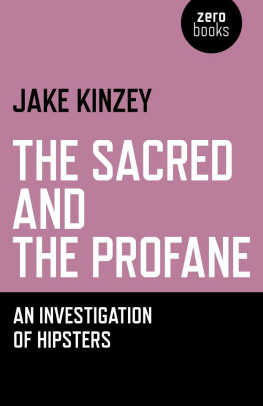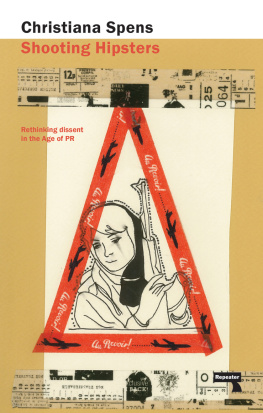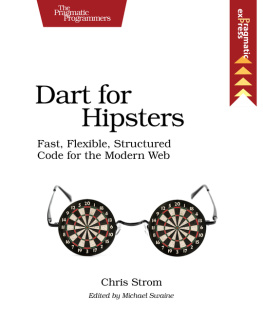The Sacred
and the Profane:
An Investigation of Hipsters

First published by Zero Books, 2012
Zero Books is an imprint of John Hunt Publishing Ltd., Laurel House, Station Approach,
Alresford, Hants, SO24 9JH, UK
office1@o-books.net
www.o-books.com
For distributor details and how to order please visit the Ordering section on our website.
Text copyright: Jake Kinzey 2010
ISBN: 978 1 78099 034 7
All rights reserved. Except for brief quotations in critical articles or reviews, no part of this book may be reproduced in any manner without prior written permission from the publishers.
The rights of Jake Kinzey as author have been asserted in accordance with the Copyright,
Designs and Patents Act 1988.
A CIP catalogue record for this book is available from the British Library.
Design: Stuart Davies
Printed in the UK by CPI Antony Rowe
Printed in the USA by Offset Paperback Mfrs, Inc
We operate a distinctive and ethical publishing philosophy in all areas of our business, from our global network of authors to production and worldwide distribution.
Dedicated to Aunt Jane, Ken Winterbottom,
William Roberts PhD and Liz Pis.
Dont pull me down, this is where I belong
I think Im different, but Im the same and Im wrong
Dont pull me down, this is where I belong
I think Im different, this is where I belong
Blink 182 Pathetic
Chapter One
The hipster has been understood in many ways, but most popular explanations are false, misleading, or at best a small piece of a larger picture. An example is N+1 Magazines recently published What Was The Hipster? The title suggests that the hipster is no longer with us (R.I.P.), but this couldnt be further from the truth. The hipster is neither dead nor buried. The children of the hippies and yuppies live! in the streets, the malls, the media, the cities and the suburbs the world over. Ironic postmodern-kitsch zombies are finding comfort in the apathy and over-consumption of late-capitalism. Is there anything new to say about the hipster? Hasnt the subject already been endlessly analyzed in books, magazines, newspapers, and blogs, etc.? Who cares? Isnt it just another subculture?
Another way to understand the hipster is through Apples well-known 1984 Superbowl Ad. Apple introduced their new line of personal computers to the general public in a well-known parody (or is it pastiche?) of 1984. The commercial is set in a grey dystopic industrial setting, with shots of a Big Brother-like figure talking to people who all look the same. Then there are full-color shots of a nameless heroine, a track star carrying a hammer, representing Apple. She throws the hammer into the screen and destroys it, liberating the grey populace.
This commercial can be read in many ways: the shift from centralized capitalism to decentered capitalism; the shift from TV to the computer; but the most powerful message the commercial seems to send is are you bored and confined within your grey late capitalist world? Do you feel like a lifeless automaton? Buying an Apple computer will revolutionize you and bring creativity and color to your life! Today its easy to see how these late-capitalist hopes are utopian (in the negative sense). Rather than endless creativity we are still stuck in conformity. An easy test is going into any college lecture hall of reasonable size and looking up: one is bound to see a sea of illuminated Apples staring back at them. The white Apple headphones became so ubiquitous that they made people easy targets for thieves on the New York subway. It seems like we have gone back to 1984 ; yet people seem to believe in bringing creativity and authenticity to their lives more than ever. By now it has become a truism that being anti-mainstream is the mainstream: here one is able to locate the truth in the typical assertion that hipsters think they are being different but really act the same.
But, while this is undoubtedly true, that is not enough to properly explain what is going on. Why do they all act the same, and why is the appearance of being unique necessary to the process? The platitude doesnt acknowledge what is distinctive about the hipster, while being able, at the same time, to show similarities to other subcultures. What is a hipster? The hipster has clearly identifiable progenitors (the bohemians, the beats, the (post-) punks etc.) but is not explained away in a narrative of previous subcultures. When asked, most people describe the hipster in terms of concrete objects they consume (what they wear, listen to, eat etc.) or as an attitude (e.g. they are elitist snobs masked in an aesthetic populism). They make the same mistake as critics who examine the hipster in isolation rather than seeing their place in larger processes (i.e. global ones). Hipsters are the most postmodern mainstream-subculture to date and are perfectly integrated into postmodern late-capitalism ( la Frederic Jameson).
Since there has been no dominant mainstream culture for a while, hipsters have reluctantly filled this empty place with their own question mark. Hipsters rarely refer to themselves as hipsters, seeing themselves as beyond labels. If hipsters do acknowledge that something like a hipster exists, they will be glad to show you that hipsters exist out there, having nothing to do with themselves. Distance and irony are key concepts in understanding this outlook. Hipsters rarely passionately believe in anything, preferring cynical distancing.
The hipster was born in the era of globalization driven by free-market fanaticism; they represent the socio-economic realities around them. It is no surprise to hear that, Across the developed world, from Copenhagen to Cape Town, from Tokyo to Sao Paolo, from Kreuzberg [in Berlin] to Williamsburg [in New York] from Grangemouth to Guildford, for that matter todays [hipsters] all wear the same clothes and accessories, listen to the same sounds, ride the same bicycles, and read the same magazines, e-mailouts and style blogs. What started as a small movement in New York can now be found on giant billboards worldwide; the hipster is the dominant aesthetic filter through which mainstream culture emanates.
The hipsters quest for perpetual cool is sustained by endless cultural imperialism: everything is potentially for the taking. In typical postmodern fashion, it seems as if nothing they do is really new , its all about sampling, bricolage, remixing, or, usually, just stealing wholesale from the past. They decontextualize and take fashions and ideas from cultures that they have little knowledge of to make their lives into a work of art. This need for uniqueness and pure authenticity usually has the peculiar effect of making their aesthetic lives into something like a postcard of Andy Warhols Campbell Soup Cans : a copy of a copy, mass-produced and unoriginal. In their attempt to achieve absolute individuality, hipsters somehow overlook the fact that they are doing the exact same thing in the same exact ways as everyone around them.
Mark Greif asked whether the 1999 model of the hipster is the true hipster like the way those from the late 1950s and early 1960s who fit the Maynard G. Krebs caricature were the only actual beatniks [i.e. the pre-Hippies], and the San Francisco arrivistes in 1967 were the only true hippies [] or is hipster a kind of permanent cultural middleman in hypermediated late capitalism, selling out alternative sources of social power developed by outsider groups, [a bunch of] infiltrators who spoil the resistancethe coolhunting collaborators and spies? One of the aims of this work is to show that hipsters are, in a way, infiltrators and spies. Not only that, but there has never been an authentic or original hipster. What gets lost in this notion is that selling out is practically programmed into the hipster .
Next page













